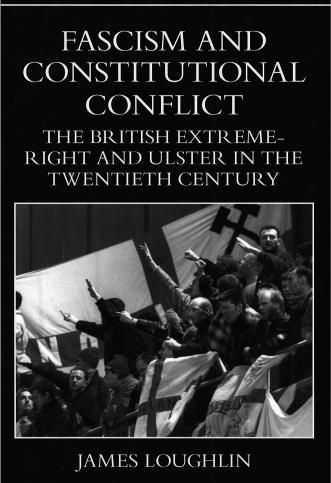FASCISM AND CONSTITUTIONAL CONFLICT: the British extreme right and Ulster in the twentieth century
Published in Book Reviews, Book Reviews, Issue 3 (May/June 2020), Reviews, Volume 28James Loughlin
Liverpool University Press
£90
ISBN 9781786941770
Reviewed by Niall Meehan
Niall Meehan is Head of the Journalism and Media Faculty in Griffith College, Dublin, and author (with Brian Murphy OSB) of The embers of revisionism (Aubane, 2017).
 Ardent Empire loyalists considered Britain’s ceding of control over 26 of Ireland’s 32 counties in 1922 a catastrophe. As with German First World War defeat, humiliation gave way to finger-pointing at the traitors and charlatans who capitulated to the inferior Irish. Britain was simultaneously squeezed by the Bolshevik Revolution on one side and US emergence on the other. Fascist ideologies emerged to blame Jewish communists and finance capitalists, plus Irish republicans, aliens all, as co-conspirators in the effort to undermine white British civilisation.
Ardent Empire loyalists considered Britain’s ceding of control over 26 of Ireland’s 32 counties in 1922 a catastrophe. As with German First World War defeat, humiliation gave way to finger-pointing at the traitors and charlatans who capitulated to the inferior Irish. Britain was simultaneously squeezed by the Bolshevik Revolution on one side and US emergence on the other. Fascist ideologies emerged to blame Jewish communists and finance capitalists, plus Irish republicans, aliens all, as co-conspirators in the effort to undermine white British civilisation.
James Loughlin’s fascinating analysis focuses on ‘Ulster’ as a site of opportunity for British fascists. Here were confirmed loyalists in a new outpost of Empire, fighting enemies inside the gate. Another reason for a loyalist emphasis is because, as Loughlin explains, Irish nationalists ‘had never been attracted by the British extreme right’. The British Fascist (BF) party hailed Edward Carson and the UVF during the 1912–14 Home Rule crisis as ‘the first of all the fascists’. Early member William Joyce, a precocious Black-and-Tan agent in Galway, later Oswald Mosley’s lieutenant and finally ‘Lord Haw Haw’ in Nazi Germany, agreed. Fleeing Ireland, he dodged an IRA assassination attempt. So too did another stalwart, Brigadier General Sir Ormonde Winter, who oversaw British intelligence efforts against the IRA after Bloody Sunday.
The BF lasted until eclipsed in the 1930s by Mosley’s British Union of Fascists (BUF). Loughlin explains in his lively and stimulating survey, spanning the period from the 1920s to 2018, that occasionally promising fascist forays into Northern Ireland usually ended in disappointment. Lord Craigavon, paraphrased by Loughlin, possibly explained it best. Noting ‘attempts to introduce fascism into Ulster’, the Northern premier reportedly replied that ‘we have all we want here’, adding: ‘We have the Orange Order, the Black Brethren, and the B Specials, and they constitute all the fascism that Ulster wants’. The book outlines the context, Lord Rothermere’s Daily Mail alliance with Mosley in 1934. A friend of Craigavon, Rothermere asked Mosley to leave Northern Ireland be. Stormont was promoted as a model of what fascist government should look like. If it ain’t broke, don’t fix it. More prosaically, British fascists did not prosper for the same reason that Labour and Tories also fail: Northern Ireland is not fully participant in the party politics of the British state.
Mosley had difficulty with anti-Catholicism, as did some others in the BUF (apart from Joyce), mainly its English Romanists. And on the other side, unionists were unconvinced by anti-Semitism. Loughlin promotes the idea of loyalist pro-Semites, though that seems a stretch. Jews, including a former Unionist lord mayor of Belfast, were forced out of the North during the First World War, because (ironically) Jews were considered German. Evangelical Protestant and South Belfast Unionist MP Revd Robert Bradford thought Ulster Protestants a lost tribe of Israel. A former party member said that Bradford’s election agent in 1974 was in the National Front. Certainly at the time they supported each other. More recent loyalist affection for Israel is partly based on its treatment of Palestinians, a model of how to deal effectively with enemies, think many unionists.
A solid base of loyalist anti-Catholicism occasionally hosts other forms of prejudice, including opposition to Muslims after 9-11, to Chinese and to Poles, plus other ethnic minorities. They experience racism in loyalist parts of Belfast, where overcrowded West Belfast Catholics fear to live. Emphasis on loyalist reaction does not preclude a nationalist variant, though, like sectarianism, it has less political purchase in that community. One aspirant West Belfast fascist gained notoriety in 1983 when he shot dead three fellow Irish Army soldiers in the Lebanon. As a 1970s schoolboy he opposed ‘red’ teachers, one in the form of Fergus O’Hare, elected a Peoples’ Democracy Belfast City councillor in 1981.
Having arrived at fascism after membership of the Conservative and then the Labour Party, after the Second World War Mosley was a busted flush. Opposition in his previous life to British repression in Ireland made him ill suited to supporting loyalist sectarianism. Alternate attempts to win over Irish immigrants and oppose partition went nowhere. His post-war ‘Europe a Nation’ project proposed that white Europeans unite and maintain dominance in Africa. It was unattractive to Little Englanders, particularly when European empires fell apart. After Mosley’s retirement, reaction to colonial collapse, much like that to Irish independence, created space for the neo-Nazi National Front. Opposing ‘coloured’ immigration and then ‘Europe’ replaced anti-Semitism as the dominant prejudice.
Similarly, unionist fear of being cast aside like Rhodesia and white South African expulsion from the Commonwealth, plus retreat from empire, hardened opposition to civil rights demands. The resultant post-1969 crisis saw National Front (NF), Combat 18, White National Party and British National Party efforts to link up with loyalism and promotion of anti-IRA sentiment. Tentative NF opposition to sectarianism in favour of fascist solidarity gave way to supporting sectarian killers and killing. Mosley occasionally made suggestions, for instance that Catholics, like ‘coloured’ immigrants, could ‘repatriate’. This saga is expertly detailed by Loughlin, whose focus on Enoch Powell indicates one route to far-right success in the North: become a unionist.
















